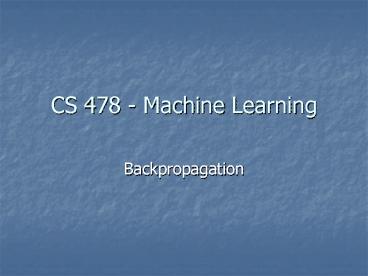CS 478 Machine Learning - PowerPoint PPT Presentation
1 / 21
Title:
CS 478 Machine Learning
Description:
The Plague of Linear Separability. The good news is: ... The result on linear separability (Minsky & Papert, 1969) virtually put an end ... – PowerPoint PPT presentation
Number of Views:52
Avg rating:3.0/5.0
Title: CS 478 Machine Learning
1
CS 478 - Machine Learning
- Backpropagation
2
The Plague of Linear Separability
- The good news is
- Learn-Perceptron is guaranteed to converge to a
correct assignment of weights if such an
assignment exists - The bad news is
- Learn-Perceptron can only learn classes that are
linearly separable (i.e., separable by a single
hyperplane) - The really bad news is
- There is a very large number of interesting
problems that are not linearly separable (e.g.,
XOR)
3
Linear Separability
- Let d be the number of inputs
- Hence, there are too many functions that escape
the algorithm
4
A Historical Perspective
- The result on linear separability (Minsky
Papert, 1969) virtually put an end to
connectionist research - The solution was obvious Since multi-layer
networks could handle in principle handle
arbitrary problems, one only needed to design a
learning algorithm for them - This proved to be a major challenge
- AI would have to wait over 15 years for a general
purpose NN learning algorithm to be devised by
Rumelhart in 1986
5
Towards a Solution
- Main problem
- Learn-Perceptron implements a discrete model of
error (i.e., identifies the existence of error
and adapts to it) but has no mechanism to account
for the amount of error - First thing to do
- Allow nodes to have real-valued activation
functions (the amount of error can then easily be
computed as the difference between the computed
output and the target one) - Second thing to do
- Design an adequate learning rule that adjusts
weights as a function of the error - Last thing to do
- Use the learning rule to implement a multi-layer
algorithm
6
Real-valued Activation
- Replace the threshold unit (step function) with a
linear unit, where
- No longer discrete
7
Training Error
- We define the training error of a hypothesis, or
weight vector, by
- Which we will seek to minimize
8
The Delta Rule
- Implements gradient descent (i.e., steepest) on
the error surface
- Note how the xid multiplicative factor implicitly
identifies active lines as in Learn-Perceptron
9
Gradient-descent Learning (b)
- Initialize weights to small random values
- Repeat
- Initialize each ?wi to 0
- For each training example ltx,tgt
- Compute output o for x
- For each weight wi
- ?wi ? ?wi ?(t o)xi
- For each weight wi
- wi ? wi ?wi
10
Gradient-descent Learning (i)
- Initialize weights to small random values
- Repeat
- For each training example ltx,tgt
- Compute output o for x
- For each weight wi
- wi ? wi ?(t o)xi
11
Discussion
- Gradient-descent learning (with linear units)
requires more than one pass through the training
set - The good news is
- Convergence is guaranteed if the problem is
solvable - The bad news is
- Still produces only linear functions
- Even when used in a multi-layer context
- Needs to be further generalized!
12
Non-linear Activation
- Introduce non-linearity with a sigmoid function
- Differentiable (required for gradient-descent)
- Most unstable in the middle
13
Sigmoid Function
- Derivative reaches maximum when output is most
unstable. Hence, change will be largest when
output is most uncertain.
14
Multi-layer Feed-forward NN
i
k
i
k
j
i
k
i
15
Backpropagation (i)
- Repeat
- Present a training instance
- Compute error ?k of output units
- For each hidden layer
- Compute error ?j using error from next layer
- Update all weights wij ? wij ?wij (where ?wij
?Oi?j) - Until (E lt CriticalError)
16
Error Computation
17
Network Equations Summary
18
Example (I)
- Consider a simple network composed of
- 3 inputs a, b, c
- 1 hidden node h
- 2 outputs q, r
- Assume ?0.5, all weights are initialized to 0.2
and weight updates are incremental - Consider the training set
- 1 0 1 0 1
- 0 1 1 1 1
- 4 iterations over the training set
19
Example (II)
20
Dealing with Local Minima
- No guarantee of convergence to the global minimum
- Use a momentum term
- Keep moving through small local (global!) minima
or along flat regions - Use the incremental/stochastic version of the
algorithm - Train multiple networks with different starting
weights - Select best on hold-out validation set
- Combine outputs (e.g., weighted average)
21
Discussion
- 3-layer backpropagation neural networks are
Universal Function Approximators - Backpropagation is the standard
- Extensions have been proposed to automatically
set the various parameters (i.e., number of
hidden layers, number of nodes per layer,
learning rate) - Dynamic models have been proposed (e.g., ASOCS)
- Other neural network models exist Kohonen maps,
Hopfield networks, Boltzmann machines, etc.

